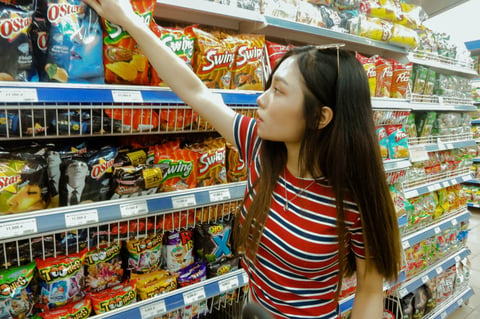
Ever stood in the grocery store confused by the string of ingredients on a product? You're not alone. Making sense of which ingredients are vegan and which aren't can be confusing, and we're here to offer some help when it comes to those hard-to-recognize "e" numbers.
So, what are e numbers?
E-numbers are codes used for food additives. They replace the chemical or common names of these additives in processed food and are used to enhance their taste, texture, or shelf life.
E-numbers can come from both plant-based and animal-derived sources. The list below doesn't mention e-numbers that are vegetarian (if they contain dairy/eggs) and the ones that can be derived from both plant and animal sources (so, depending upon the company producing it, it may or may not be vegan). This article only focusses on the numbers that are definitely not vegan. So, if you're shopping vegan, these numbers aren't your friends.

See also: A guide to eco-labels so you don't get greenwashed
1. e120 (Carmine/Cochineal)
e120, also known as carmine or cochineal, is used to give a "pink" or "red" hue to food. You may find it in foods like cakes, ice cream, and yogurt. In 2011, the United States passed a law stating that manufacturers will have to mention e120 on their packaging if that is the ingredient they are using, instead of just writing "added color". This led to many companies changing their recipes and opting to use beetroot instead!
Cochineal is an insect that lives on cacti. They produce a rare carminic acid which helps them ward off predators (since they're quite small in size), the acid stops bigger insects from eating them). This acid is the source of the red color found in carmine. The bugs are ground, boiled, and the resultant solution is filtered to get e120. It takes over seventy thousand bugs to produce 1 pound of cochineal dye, and Peru, the world's biggest exporter, produces 200 tons of dye each year.
e120 is also a key ingredient in many beauty products, especially red lipsticks and nail paints.
2. e542
e542 is edible bone phosphate which comes from ground animal bones. Generally, it's added to powdered products to prevent it from forming lumps or to encourage suspension of one liquid into another. It's also added to various dietary supplements as a source of phosphorous and is used in various beauty products, especially toothpaste.

3. e901(Beeswax)
Beeswax is a polymer produced by bees. It's usually yellow in color [e901 (i)] or is dried or processed with hydrogen peroxide so that it becomes white [3901 (ii)]. It's usually found in food that has a distinct "honey" flavor or is used in chewing gums or as a coating or glazing agent.
See also: 7 brands creating tasty tipples from food waste
4. e904 (Shellac)
Shellac is derived from female lac bugs. These bugs are attracted to the bark of the Lac tree and they feed on it's sap. When the sap enters a female bug's body, it's chemically altered and is then exuded onto a branch of the tree, this is called "Sticklac". After the breeding season, sticklac is collected by the workers, and the crusty coating from the branches is collected and sent for processing. This coating is raw shellac and it contains the bugs and pieces of the bark, which is further processed to get e904.
Shellac is generally used as a glazing agent when coating pills and sweets. It's also used as a brush-on colorant in nail polish and furniture polish.

5. e913 (Lanolin)
Lanolin comes from the oil found on sheep's wool. Lanolin is found as a by-product of the wool industry. So, while the sheep aren't killed to procure lanolin, many sheep are kept in captivity for their wool. In order to ensure proper wool production, the sheep are genetically modified to produce thicker and longer wool, which means the sheep lose their natural capacity to shed. So, now the sheep have to be shorn manually.
Lanolin is usually found in chewing gum and is used as a food "softener". Sometimes, instead of being specifically mentioned in the ingredient list, lanolin can be mentioned vaguely as "gum base".
See also: 10 online thrift stores for sustainable fashion
6. e966 (Lactitol)
e966 or Lactitol has 40% of the sweetness of sugar. It is derived from an ingredient called Whey, which comes from cow's milk. In its natural form, this milk contains two types of protein: casein and whey. When the milk is heated in the cheese-making process, it gets split into curds and whey liquid. This liquid is further processed to obtain e966.
Lactitol is a sugar alcohol that's used as a sugar replacement in various commercially produced low-calorie food.











































